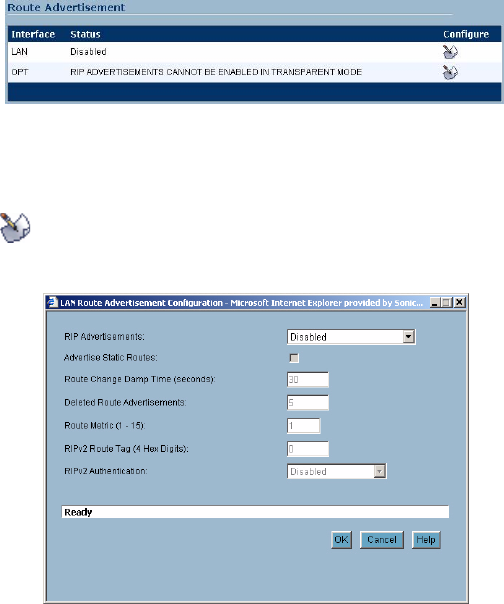
SONICWALL SONICOS STANDARD 3.0 ADMINISTRATOR’S GUIDE
91
Network > Routing
If you have an Internal (LAN) router on your network with the IP address of 192.168.168.254, and
there is another subnet on your network with IP address range of 10.0.5.0 - 10.0.5.254 with a subnet
mask of 255.255.255.0. To configure a static route to the 10.0.5.0 subnet, follow these instructions:
Click Network, and then Routing.
1
Click Add in the Static Routes section.
2
Enter 10.0.5.0 in the Destination Network field.
3
Enter 255.255.255.0 in the Subnet Mask field.
4
Enter 192.168.168.254 in the Default Gateway field. This is the IP address of the internal (LAN)
router that is local to the SonicWALL security appliance.
5
Select LAN from the Interface menu.
6
Click OK.
9
Tip: Be sure the Internal (LAN) router is configured as follows: If the SonicWALL security appliance is
in NAT Enabled mode, the internal (LAN) router needs to have a route of last resort (i.e. gateway
address) that is the SonicWALL security appliance LAN IP address.
Route Advertisement
The SonicWALL security appliance uses RIPv1 or RIPv2 to advertise its static and dynamic routes to
other routers on the network. Choose between RIPv1 or RIPv2 based on your router’s capabilities or
configuration. RIPv1 is an earlier version of the protocol that has fewer features, and it also sends
packets via broadcast instead of multicast. RIPv2 packets are backwards-compatible and can be
accepted by some RIPv1 implementations that provide an option of listening for multicast packets.
The RIPv2 Enabled (broadcast) selection broadcasts packets instead of multicasting packets is for
heterogeneous networks with a mixture of RIPv1 and RIPv2 routers.
Route Advertisement Configuration
To enable Route Advertisement for an Interface, follow these steps:
1
Click the edit icon in the Configure column for the interface. The Route Advertisement
Configuration window is displayed.
